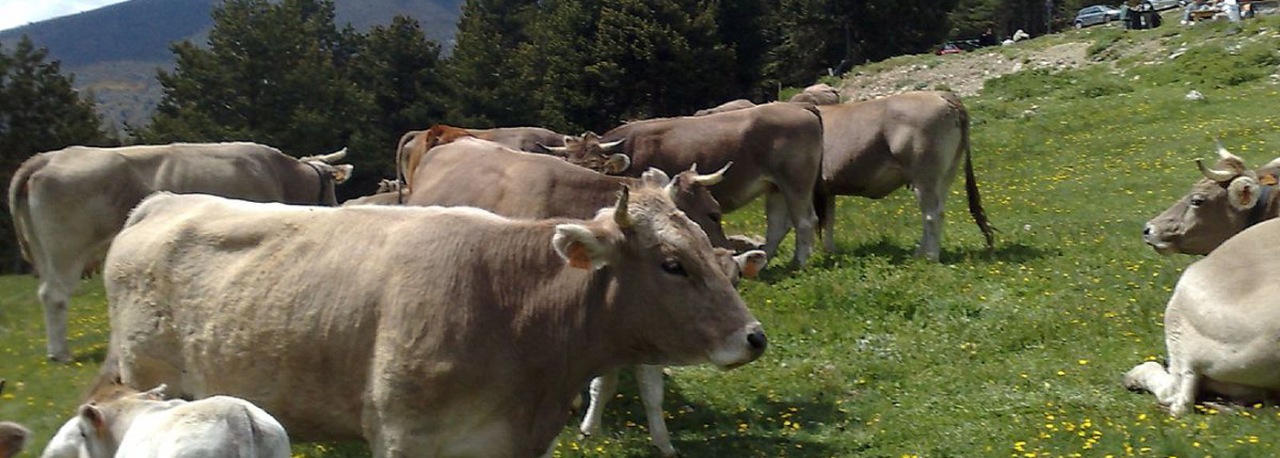.png.transform/rendition-xs/image_image%20(1).png)
Ternera de los Pirineos Catalanes/ Vedella Dels Pirineus Catalans /Vedell Des Pyrénées Catalanes PGI
Veal obtained from the hardy Pyrenean Brown, Aubrac or Gascon breeds or from the cross-breeding of dams of these hardy breeds with males of the Charolais, Limousin or Blonde d'Aquitaine breeds
Given the linguistic specificities of the area, the product may be referred to in any of the three languages used in the geographical area defined for this protected geographical indication (Spanish, Catalan or French).
Tasting notes
The meat colour ranges from pink to bright red. The fat is white to cream in colour and intramuscular fat is observable. It is excellent quality meat that is exceptionally tender.
Other notes
The eligible carcasses are classified as E, U or R on the EUROP grid, with profiles ranging from ‘super-convex’ to ‘straight’ and with muscle development that ranges from ‘exceptional’ to ‘good’. The fat cover of the carcasses is graded 2-3-4 on the EUROP grid. The minimum carcass weight is 160 kg.
Production / Processing method
The calves feed on maternal milk and fresh fodder for at least the first four months of life. After weaning and during the growth and fattening stages, the livestock is fed on dried fodder and a well-balanced mix of ground cereals and pulses.
The meat-production steps that must take place in the defined geographical area are:
- Birth
- Rearing: extensive grazing on farm pastures or summer mountain pastures for at least the first four months of life.
- Weaning: from the age of four months.
- Growth and fattening: the facilities must be enclosed or semi-enclosed, provide each animal with at least 3 m2 and a rest area separate from the feeding zone. Lots comprise a maximum of 20 animals.
It is not compulsory for slaughtering and butchering to take place in the area.
Transport time prior to slaughter is limited to three hours so that stress to the animals is kept to a minimum, thereby guaranteeing the quality of the finished product.
The carcasses must be left to rest to age for at least six days before sale to the public.
Geography / Relief and climate
The geography of the Catalan Pyrenees is favourable to extensive cattle rearing. It is characterised by paths and mountain pastures at high and low altitude, with extensive natural pasture land for the animals for much of the year, until the weather conditions become difficult. The area is influenced by the Mediterranean (humid, sub-Mediterranean climate), which means that the animals can spend longer in the summer pastures and mountain meadows.
The abundance of water and good exposure to sunlight favour the development of the rich and characteristic flora (particularly Festuca pratensis, Festuca alpina, Poa pratensis, Dactylis glomerata, Sesleria caerulea, Bromus erectus and Arrhenatherum elatius), which creates excellent grazing areas for the cattle. It also allows farmers to sow mixtures of grasses and legumes in the meadows in the mid-mountain zone to feed the cattle during periods when the high-altitude mountain pastures are inaccessible. The most common forage crops are clover, ryegrass, lucerne (alfalfa), sainfoin and fescue.
Regulatory Council
Consejo Regulador de la IGP Ternera de los Pirineos Catalanes
Partida de Sant Esteve, 6, E
25700 La Seu D`Urgell (Lleida)
T: + 34 973 351 492
F: + 34 973 354 230
igp@vedellapirineus.cat
www.vedellapirineus.cat
Source:
It is excellent quality meat that is exceptionally tender.


- Ternera de los Pirineos Catalanes 1
- Ternera de los Pirineos Catalanes 2

La Seu D'Urgell - Lleida (Catalonia)
